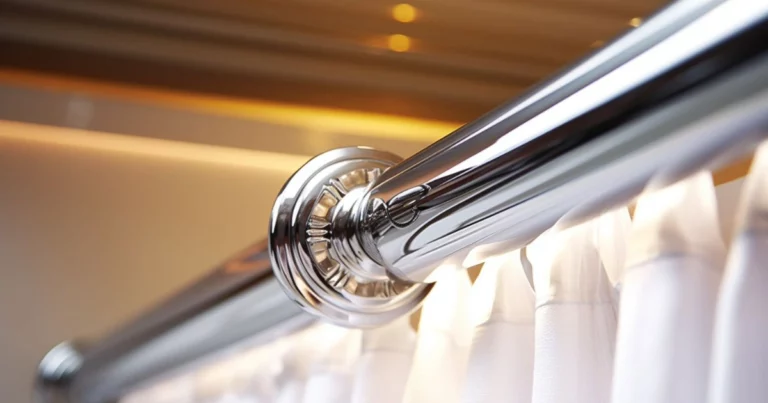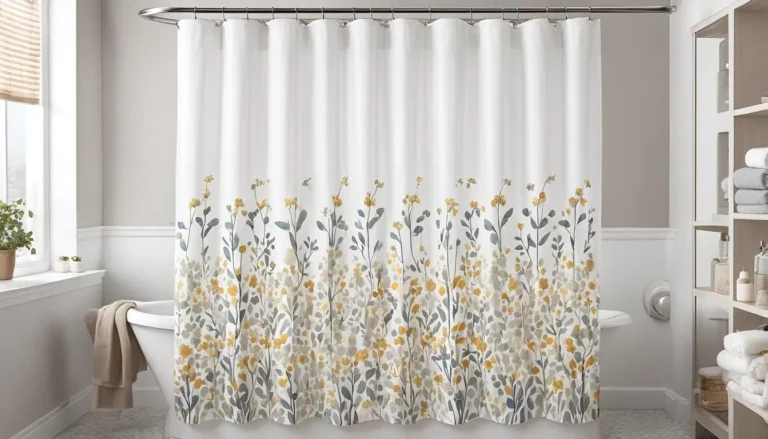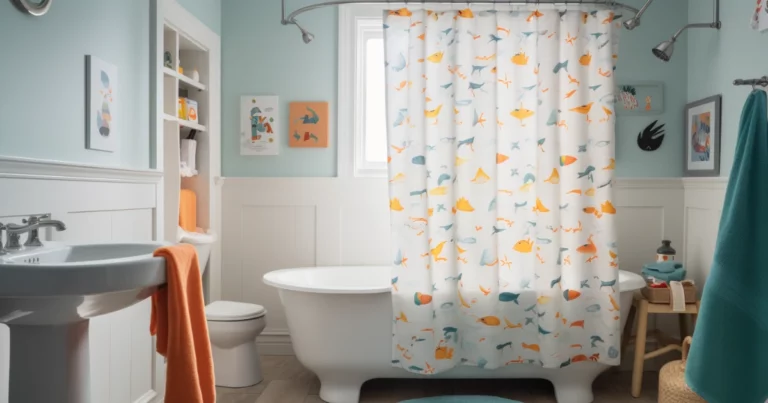What is a Shower Curtain Made of? A Guide to the 4 Best Materials for Shower Curtains
As Midas touches objects to turn them to gold, you select a shower curtain to transform your bathroom. But what is a shower curtain made of? Do you know what materials you’re inviting into your space?
Vinyl is inexpensive but often harbors chemicals like phthalates. It can volatilize and affect air quality. If you’re eyeing durability and style, fabric curtains could be your go-to. They combine easy maintenance with a flair of sophistication.
As you weigh your options, balance cost, health considerations, environmental impact, and design. It’s a meticulous decision. But understanding the materials ensures you don’t compromise on quality or safety.
Table of Contents
What is a Shower Curtain Made of? Materials Used in Shower Curtains
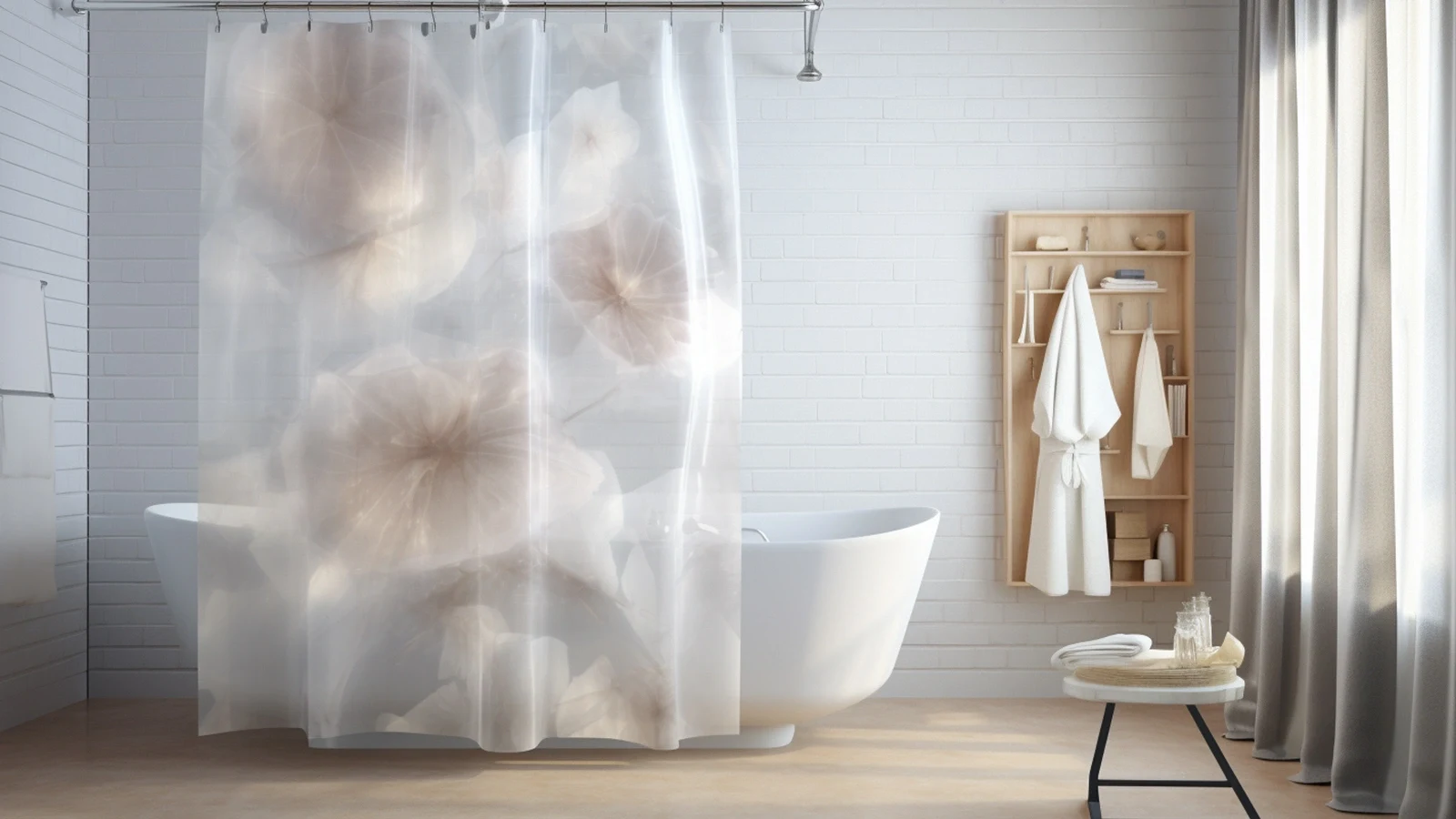
When selecting your shower curtain, you’ll need to weigh the properties of materials like vinyl, PEVA, and various fabrics.
Each type offers distinct features. Vinyl provides cost efficiency but raises concerns due to its phthalate content and VOC emissions.
In contrast, fabric options offer durability and the convenience of being machine-washable. They cater to both aesthetic preferences and practical considerations.
Types of Shower Curtain Materials
You’ll come across various materials when picking out a shower curtain. Each has its own set of benefits and drawbacks. Here’s a technical rundown:
- PVC Shower Curtains: Made from polyvinyl chloride, these offer affordability. But they may raise concerns due to potential toxic fumes and high phthalate content.
- EVA Shower Curtains: Ethylene-vinyl acetate is a healthier, chlorine-free alternative to PVC. It emits fewer volatile organic compounds (VOCs).
- Fabric Shower Curtain: These curtains are usually crafted from polyester and deliver a soft appearance. They are lauded for their quietness and ease of maintenance.
- Polyester Shower Curtains: They are a subset of fabric curtains known for water repellency and durability. They often serve as a stylish and practical bathroom staple.
Choose your shower curtain material wisely. Balance aesthetics, functionality, and health considerations.
Features of 3 Primary Materials
Explore the three primary materials used in shower curtains—vinyl, PEVA/EVA, and fabric. Each offers distinct features that cater to different preferences and requirements.
A vinyl shower curtain, often waterproof and cost-effective, remains a popular choice. But you might encounter the drawback of chemical odors due to the phthalates in their composition.
PEVA/EVA is a PVC-free alternative. It boasts a lower environmental impact and reduced volatile organic compounds (VOCs). It is a safer choice for your home.
Meanwhile, fabric shower curtains elevate your bathroom’s aesthetic with a softer texture and varied design possibilities. In addition, some fabric showers come with antimicrobial properties, enhancing hygiene and durability.
How to Select the Right Shower Curtain Material
Selecting the right shower curtain material requires considering some factors. Here’s what you need to know:
- Vinyl Shower Curtains: Made of PVC or vinyl, these curtains are water-resistant and affordable. But they can release VOCs, so ventilation is key.
- PEVA: As a non-chlorinated vinyl, PEVA is a healthier alternative with fewer chemical concerns. It’s also water-resistant and relatively durable.
- Polyester Shower Curtains: Polyester offers a balance between functionality and aesthetics. It’s mold-resistant and can have a fabric-like feel, but it’s quick-drying.
- Cotton Shower Curtain: Cotton is a machine-washable and eco-friendly natural fiber. They need a water-repellent liner to prevent mold and mildew growth.
What is a Shower Curtain Made of? Shower Curtain Liners

Shower curtain liners are crucial, acting as a moisture barrier. They protect your decorative outer curtain and bathroom floor.
Examine common materials such as vinyl and fabric. Each has unique properties affecting durability, maintenance, and health impact.
Plastic or vinyl liners offer affordability and water resistance. Fabric provides a premium aesthetic and is usually machine washable for easy care.
Purposes of Shower Liners
Why should you consider a liner when choosing your shower curtain? A shower curtain liner is essential for several technical and craft-specific reasons:
- Water Barrier: Liners act as a water-repellent shield. They prevent moisture from escaping the shower area and causing potential water damage.
- Mold Prevention: A vinyl liner or a fabric alternative reduces the risk of mold and mildew buildup. Thus they can extend the life of your shower curtain.
- Enhanced Privacy: Liners provide an opaque layer. It can add extra seclusion while showering.
- Shower Curtain Protection: Using a liner will protect your shower curtain from direct contact with water and soap scum. It helps maintain the curtain’s aesthetic appeal and reduces the frequency of washes needed.
Common Liner Materials
Shower curtain liners come in various materials, like vinyl, PEVA, fabric, and more. Each has its own set of benefits and drawbacks.
Vinyl liners are cost-effective and water-resistant. But they can release VOCs and contain phthalates, raising health concerns.
On the technical side, polyester liners offer durability and mildew resistance. They are often favored for their longevity and ease of cleaning.
For a more eco-conscious choice, PEVA or EVA liners present a chlorine-free and low-VOC alternative. They can significantly reduce exposure to noxious fumes.
When evaluating these materials, it’s essential to consider mildew resistance, environmental impact, and maintenance requirements to meet your needs.
Plastic or Vinyl Liners
What’s often overlooked when choosing shower curtain liners is plastic or vinyl materials’ prevalence and potential impact. Here’s a precise breakdown:
- Vinyl Curtain Toxicity: Vinyl curtains may release volatile organic compounds (VOCs) and phthalates. They can trigger adverse health effects.
- Shower Liner Durability: Despite health concerns, vinyl shower liners are water-repellent and low-cost.
- Shower Curtain Material Options: PEVA and EVA are better alternatives to vinyl. Because they don’t give off dangerous chemicals.
- Compatibility: Ensure the chosen material complements the shower stall environment. Balance functionality with health considerations.
The appropriate material must weigh these factors for a safe and functional bathroom space.
Fabric Liners
You’ll find that fabric liners offer a stylish and washable alternative to their plastic counterparts. When selecting a liner made of fabric, you’re choosing a product crafted from materials such as nylon, polyester, or cotton. Each material brings its own benefits.
Nylon and polyester fabric liners are popular for their superior water-repellent properties. They can shield your bathroom floor from water spillage.
By opting for a cotton liner, you’re embracing a touch of luxury with its plush texture. However, these liners demand regular laundering to deter mold and mildew proliferation. For your fabric liner cover to last and work well, you need to take good care of it and reuse it, which is also good for the environment.
Factors to Consider When Choosing a Shower Curtain
When selecting a shower curtain, there are some factors you need to consider.
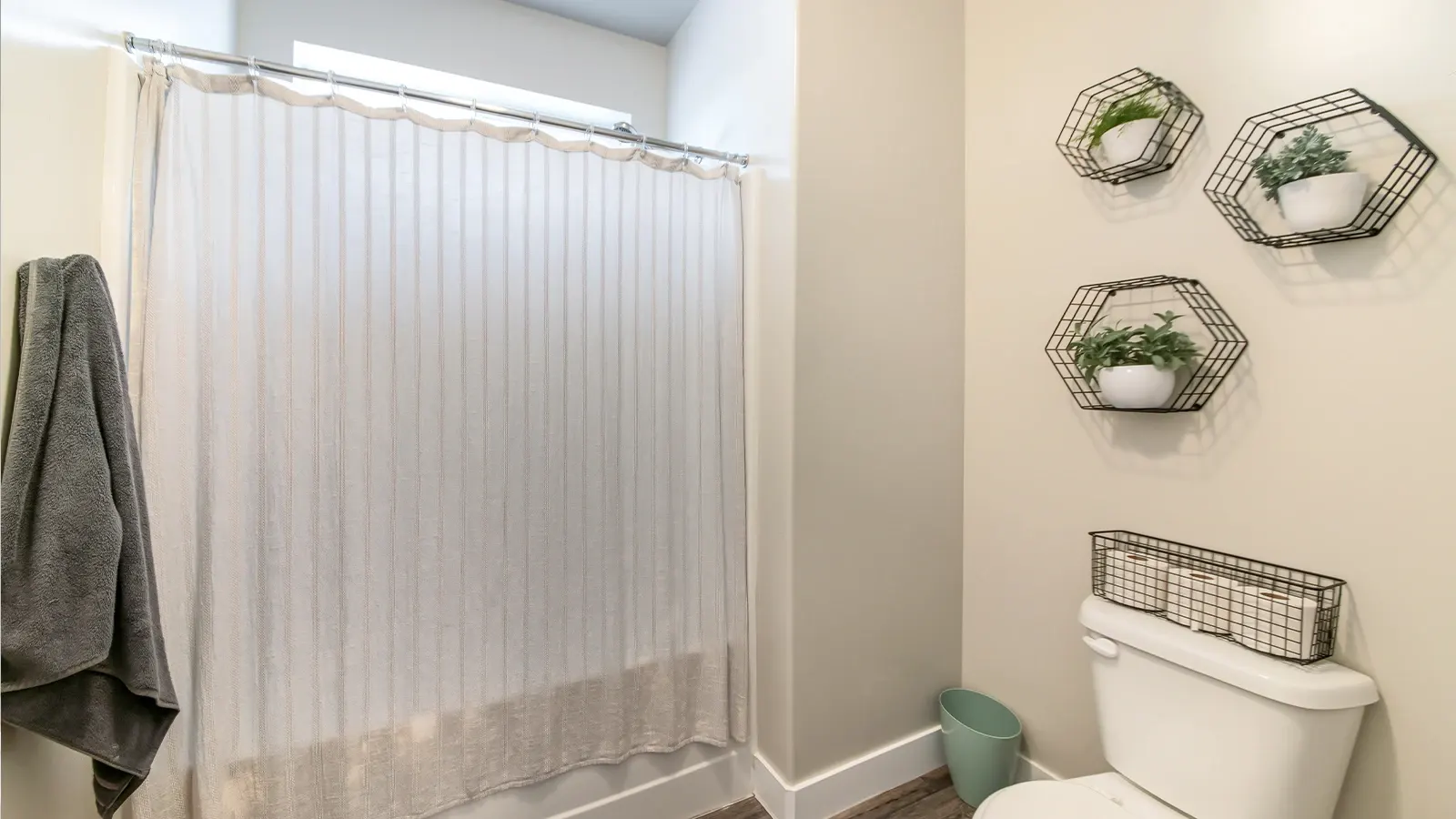
Size Matters
Selecting the correct size is as essential as the material. This ensures it fits well and provides proper coverage. When choosing the right shower curtain for your bathroom, consider the following:
- Standard Shower Curtain Dimensions: A standard shower curtain usually measures 72′ x 72′. Ensure your fabric choice can accommodate this size or is ample enough to create a full look.
- Stall Showers: For stall showers, a 50′ x 78′ curtain may be more appropriate to achieve the ideal fit.
- Extra-Long Options: An extra-long shower curtain provides more length to prevent water from escaping.
- Customization: Add extra inches for hems and seams if you’re crafting the curtain yourself. Ensure a tailored fit that hangs correctly.
Extra-Long Shower Curtains
Considering the dimensions of your shower space, you’ll need to weigh various factors if you need an extra-long shower curtain. Select a shower curtain material adept at repelling moisture. Options like vinyl and polyester blends are ideal.
For a tailored fit, combine two panels, measuring to encompass both the breadth and desired drape. Precision in the hemming process is critical to ensuring an even and professional finish.
Crafting the top hem needs a double fold, each four inches pressed flat. Insert a strip of interfacing for structural support when working with lightweight fabrics.
When affixing shower curtain rings or hooks, evenly spaced, reinforced grommets are essential. Align them with the shower curtain rod’s width. This guarantees smooth functionality and an elegant hang.
Stall, Standard, or Tub Size
You’ll need to choose a shower curtain that fits your specific stall, standard, or tub size. Consider both the width and height for optimal coverage. Here’s what you should keep in mind:
- Shower Stall Dimensions: Measure the opening of your shower stall to ensure the curtain will span the entire space. A standard shower curtain is 72′ x 72′, while a stall curtain typically measures 50′ x 78′.
- Curtain Rod Placement: The curtain rod’s height can affect the length of the shower curtain needed.
- Tub Compatibility: If you have a tub, ensure the shower curtains come in a size that provides enough overlap to contain water within the tub area.
- Material and Hemming: Select a moisture-resistant material. When customizing the shower curtain’s dimensions for a perfect fit, account for hemming.
Decorative Tips for Shower Curtains
When selecting your shower curtain, you can decorate it from various angles.

Patterns and Designs
Dive into the vast array of patterns and designs for shower curtains to spruce up your bathroom’s aesthetic. When choosing the right decorative touch, consider the following:
- Floral Printed Shower Curtain: Ideal for adding a touch of nature. Ensure the floral pattern harmonizes with the existing design of your bathroom.
- Geometric Patterns: For a modern twist, geometric shapes can bring a dynamic look. But balance them against softer bathroom decor elements.
- Stripes and Solids: Classic stripes or solid colors offer a clean, minimalist approach. They can complement various styles without overwhelming the space.
- Mix and Match: Coordinate your patterned shower curtain with other accessories. But avoid clashing by selecting complementary colors and motifs.
Colorfastness of the Dyes
You’ll find the colorfastness of the dyes critical when choosing a shower curtain. It ensures the vibrant hues stay true even after repeated exposure to water and cleaning agents.
When it comes to shower curtain material, manufacturers must select dyes that:
- Resist fading under the stress of moisture and heat encountered in bathroom environments.
- Reduce the release of volatile organic compounds (VOCs), ensuring safer indoor air quality.
- Adhere well to the shower curtain made from selected fabrics, maintaining pattern integrity.
- Follow industry standards for safety and environmental impact. Reduce potential harm to both users and ecosystems.
Conclusion
As you select your shower curtain, weigh the materials’ impact on health and the environment. Opt for PEVA or EVA to dodge toxic VOCs. Or choose washable fabric for a refined look and effortless maintenance.
Your choice is a balance of aesthetics, eco-consciousness, and well-being. All these ensure your bathroom reflects your style and values.
Make a choice that resonates with your lifestyle, and enjoy a space that’s as healthy as it is attractive.



